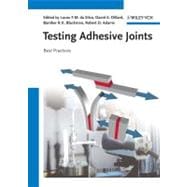
Note: Supplemental materials are not guaranteed with Rental or Used book purchases.
Purchase Benefits
Looking to rent a book? Rent Testing Adhesive Joints Best Practices [ISBN: 9783527329045] for the semester, quarter, and short term or search our site for other textbooks by da Silva, Lucas F.M.; Dillard, David A.; Blackman, Bamber; Adams, Robert D.. Renting a textbook can save you up to 90% from the cost of buying.
| Manufacture of Quality Specimens | |
| Bulk by Hydrostatic Pressure | |
| Bulk by Injection | |
| Bulk by Pouring | |
| Lab Joints with Flat Adherends | |
| Thick Adherend Shear Test | |
| Modified Thick Adherend Shear Test | |
| Stepped Joint | |
| Butt Joint | |
| Napkin-Ring | |
| T-Peel | |
| Peel | |
| Pin-and-Collar | |
| Specimens for Fracture Properties (Double Cantilever Beam and Tapered Double Cantilever Beam) | |
| Double Cantilever Beam (DCB) Specimens | |
| Bonded Wood DCB Specimens | |
| Arcan | |
| Quasi-Static Constitutive and Strength Tests | |
| Bulk Tension | |
| Bulk Compression on Cube | |
| Bulk Compression on Flat Specimen | |
| Iosipescu or V-Notched Beam Shear | |
| Butterfly | |
| Butt Joint in Tension | |
| Butt Joint in Torsion | |
| Napkin-Ring Test | |
| Thick Adherend Shear Test | |
| Modified Thick Adherend Shear Test | |
| Lap Joints with Flat Adherends | |
| Arcan | |
| Quasi-Static Fracture Tests | |
| Bulk Fracture | |
| Double Cantilever Beam | |
| Tapered Double Cantilever Beam | |
| End Notched Flexure | |
| End Loaded Split | |
| Four Point End Notched Flexure | |
| Bulk in Torsion with a Notch | |
| Mixed Mode Flexure | |
| Asymmetric Double Cantilever Beam | |
| Compact Mixed Mode | |
| Reeder and Crews Mixed Mode Bending | |
| Spelt Mixed Mode Bending | |
| Fracutre of Wood DCB Specimens | |
| T-Peel | |
| Peel at 180 | |
| Floating Roller Test | |
| Climbing Drum Test | |
| Analyzing Peel Tests | |
| Higher Rate and Impact Tests | |
| Pendulum Test | |
| Impact Wedge-Peel | |
| Fracture at High Rates | |
| Split Hopkinson Bar | |
| Clamped Hopkinson Bar | |
| Drop Weight | |
| Alternative Impact Methods | |
| Falling and Driven Wedge Tests | |
| Durability | |
| Creep | |
| Wedge Test | |
| Fatigue | |
| Impact Fatigue | |
| Fracture Fatigue | |
| Curvature Mismatch | |
| Other Test Methods | |
| Thermal Characterization | |
| Residual Stresses by Bimaterial Curvature | |
| Pull Off Test | |
| Pressurized Blist Tests | |
| Shaft Loaded Blister Tests | |
| JKR Measurements | |
| Tests under Hydrostatic Pressure | |
| Table of Contents provided by Publisher. All Rights Reserved. |
The New copy of this book will include any supplemental materials advertised. Please check the title of the book to determine if it should include any access cards, study guides, lab manuals, CDs, etc.
The Used, Rental and eBook copies of this book are not guaranteed to include any supplemental materials. Typically, only the book itself is included. This is true even if the title states it includes any access cards, study guides, lab manuals, CDs, etc.